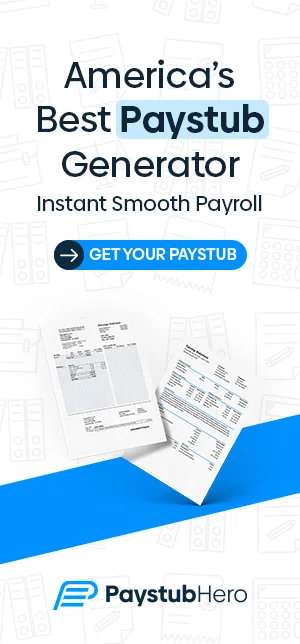We all earn money from jobs, but only some of the money we earn is ours to keep. Some of it goes to things like taxes, and what’s left is our ‘take-home pay.’ A pay stub shows us these details.
What is a paystub?
A pay stub is an earnings statement. It shows what you earned, what taxes were taken, and any other deductions for a specific time. This is super important in your financial life.
Now, let’s talk about pay stubs, why they’re important, when you need them, and how to get yours.
Types of Paystubs
Paystubs come in two primary forms: electronic and physical. Each type has its own benefits that match what employers and employees prefer.
Electronic Paystubs
Electronic paystubs are digital counterparts of traditional ones, available via emails or on employee portals. They are a short-cut and ecologically friendly substitute for paper vouchers. You can access your pay information at any time and from anywhere.
This is a great help to those who work remotely or are always on the move. In addition to saving paper, you can keep a simple record.
Physical Paystubs
Alternatively, physical pay stubs are printed copies that employees usually receive along with their paychecks. Some people prefer this method as it provides a hard copy that can be filed and saved for personal records.
In certain situations, they can be particularly important for those who may need more access to digital services.
No matter their form, both types serve the same primary purpose: showing an employee’s pay, taxes, and deductions.
Components of a Pay Stub
Here’s a breakdown of the pay stub’s key components:
1. Employer and Employee Information
A paystub starts with the employer and employee information. This part has the company’s name, address, employee name, and ID number. The details verify the identity of both the employer and the employee, ensuring that the paystub is personalized.
It also ensures the employee’s earnings are accurately recorded for financial purposes, e.g., employment or tax.
2. Pay Period and Pay Rate
The pay period section outlines the time the paystub covers, such as weekly, bi-weekly, or monthly.
The pay rate shows how much you earn, which could be an hourly or salary.
This part is crucial as it helps you understand how your pay is calculated over a specific period. It also serves as a record for you and your employer to track the consistency of payments over time.
3. Gross Wages
Gross wages represent the total amount earned before any deductions are made. This includes regular pay, overtime, bonuses, and any other earnings. It’s the starting point for understanding an employee’s compensation.
Knowing the gross pay is vital for budgeting and planning and showing your total earnings before deductions.
4. Deductions
Deductions are the amounts taken out of your paycheck before you get your final pay. They can be categorized into various types, each serving a different purpose.
Below are the common types of deductions:
Tax Withholdings
- Federal Taxes:
These are mandatory contributions to the federal government’s revenue. They are used to fund national programs and services.
The amount withheld is determined by the employee’s earnings, tax filing status, and the number of allowances claimed.
- State Taxes:
Similar to federal taxes, these are contributions to the state government. The rates and regulations vary by state.
- Local Taxes:
In some areas, local governments also require tax withholdings. These may fund local services such as schools, transportation, and public safety.
Social Security and Medicare
- Social Security:
This U.S. government program provides retirement, disability, and survivor benefits. Employers and employees contribute a set percentage of earnings up to a specific annual limit.
As per the IRS, both the employer and the employee each contribute 6.2%, making a total of 12.4%.
- Medicare:
A federal health insurance program primarily for individuals aged 65 and older, as well as for some younger people with disabilities. Like Social Security, it is funded by payroll taxes.
Right now, Medicare costs 1.45% for both the employer and the employee, which adds up to 2.9% altogether.
Voluntary Deductions
- Retirement Contributions:
Employees can put some of their money into retirement savings like a 401(k) plan. These contributions are often made pre-tax. This reduces the individual’s taxable income.
- Health Insurance Premiums:
Many employers offer health insurance plans. Employees can opt to have their share of the premiums deducted from their paychecks. Often, it’s on a pre-tax basis, which can also lower their taxable income.
These deductions keep things legal and help with long-term financial health. You should know these to handle your money well.
5. Net Pay
Finally, the net pay is the amount the employee takes home after all deductions have been made from the gross wages. It’s the actual ‘pocket’ money an employee receives and can spend.
Net pay is crucial for employees because it’s their income for living expenses, savings, and investments. It’s the bottom line that matters most to employees when they review their paystub.
Pay Stub Example
What does a pay stub look like? Here is a standard pay stub, including all the sections we’ve discussed.
The Necessity of Paystubs
You will be required to have a pay stub when:
Applying for Loans or Credit
When you apply for a loan or credit, lenders typically ask for your pay stubs to verify your income. This is essential for determining your loan eligibility and the amount you can borrow.
Interesting Read: Loan with Paystub: Guide for Individuals & Small Businesses
Renting an Apartment or Home
Landlords often request pay stubs to ensure potential tenants have a steady income and can afford the rent. By reviewing your paystubs, landlords can gauge your financial stability and reliability as a renter.
This reduces the risk of future payment issues.
Filing Taxes
During tax season, pay stubs are crucial for reporting your income and taxes paid accurately. As shown above, they include vital details required to complete tax forms, including total income earned and deductions.
Addressing Discrepancies in Wages
If there’s ever a discrepancy in your wages, paystubs serve as a record to help resolve the issue. This is because they provide a history of your earnings, deductions, and net pay.
You will hence receive the correct compensation.
Doing Financial Planning
Pay stubs are a reliable source of information for personal budgeting and financial planning. They help you track your income, manage expenses, and plan for savings and investments.
Understanding your net pay and deductions is key to making informed financial decisions.
How to Get Pay Stubs: Employees vs. Contractors
Getting your pay stubs is easy whether you’re an employee or contractor, and there are different ways for each.
For Employees
You can use Pay Stub Hero online or ask your employer for a copy if you’re an employee.
For Employers and Contractors
For employers and contractors, Paystub Hero is the best option. You can enter all the necessary details online, and the service does the tax calculations. Once everything’s checked, you can download or email the pay stub.
It’s simple and saves time for everyone.
Pay Stubs Made Simple With Paystub Hero!
Fast. Simple. Accurate. That’s Paystub Hero for you. Whether you’re an employee, employer, or contractor, creating pay stubs has never been easier.
With Paystub Hero, it’s just a few clicks away. Our platform is designed for ease of use, ensuring you spend less time on paperwork and more on what matters most. No fuss, no muss—just your pay stub, ready when you are.
Why wait? Get started now with Paystub Hero. Your first step to a clearer financial path is just a click away.
FAQ
What information is typically included on a paystub?
A paystub usually includes details such as gross earnings, taxes withheld (federal, state, and local), deductions for benefits like health insurance or retirement plans, net earnings (take-home pay), and year-to-date totals for earnings and deductions.
Why is a paystub important?
Paystubs serve as a record of employees’ earnings and deductions. They provide transparency regarding how much employees are paid and how much is deducted for taxes and other purposes. Paystubs also help employees reconcile their earnings with their hours worked and ensure accuracy in payment.
How often do I receive a paystub?
Paystubs are typically provided with each paycheck, whether it’s issued weekly, bi-weekly, or monthly, depending on the employer’s payroll schedule.





